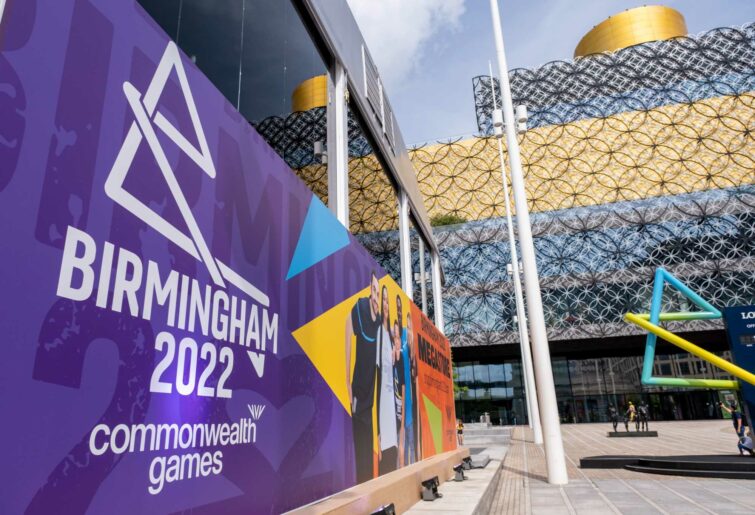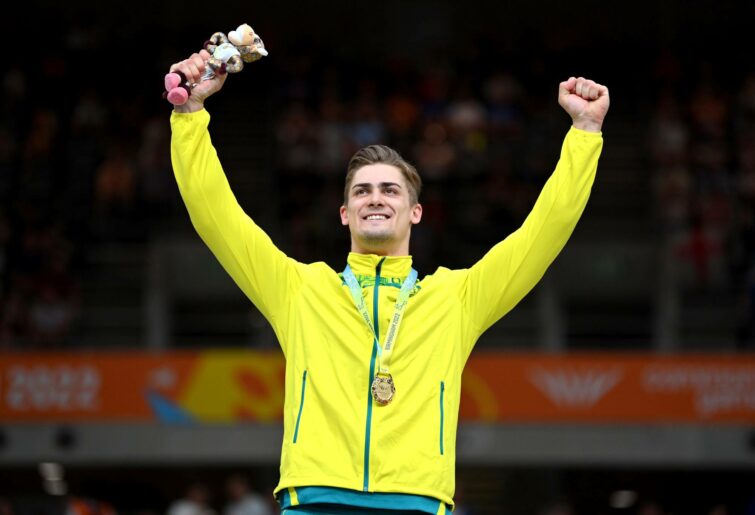The next Commonwealth Games, to be held between the dates of March 17-29 in four years’ time, will mark a departure from previous Games whereby they had been mostly concentrated to one city, or in the case of the Gold Coast in 2018, one region.
Events in Victoria will be spread across four hubs, with the Opening Ceremony to be held at the Melbourne Cricket Ground, which received its most recent major redevelopment prior to the 2006 Games which the city of Melbourne hosted to much fanfare and success.
Among other events, Geelong will host the hockey, gymnastics and aquatics, Ballarat the athletics (at a redeveloped Eureka Stadium) and boxing, Bendigo the cycling and netball, and Gippsland the rugby sevens.

A generic image of the signage of the 2022 Commonwealth Games in Birmingham, England. (photo by Mike Kemp/In Pictures via Getty Images)
Twenty20 cricket, which proved to be a major success with the Australian women’s cricket team winning the inaugural gold medal in the sport in Birmingham, will be spread across all four hubs while cycling will take place across Bendigo and Gippsland.
Victoria 2026 could potentially provide a gauge as to whether a regional event could work in the future, with talk that a multi-country format could also be the way to go.
The two most prominent examples of multi-country events will come within the next four years, with Australia and New Zealand jointly co-hosting next year’s FIFA Women’s World Cup, and Canada, Mexico and the United States co-hosting the 2026 FIFA World Cup across 16 cities.
But just imagine for a moment what a Greater Western Sydney-based Commonwealth Games could look like.
An ideal year to potentially host the event would be 2038, which would mark the centenary of the only other time Sydney hosted the event, then known as the British Empire Games, in 1938, long before they would successfully host the Summer Olympics in 2000.
At the time, only four major venues were used – the Sydney Cricket Ground, Sydney Sports Ground (the site on which the brand new Allianz Stadium is due to open later this month), North Sydney Swimming Pool and Henson Park.
By 2038, Western Sydney Airport will have been operational for more than a decade, and athletes could easily be transported to various hubs in Homebush Bay, Parramatta, Penrith, Liverpool and Campbelltown without having to traverse through the Sydney CBD.
The lead-up to the Sydney Olympics saw major infrastructure projects undertaken to ensure the city was ready to host the games by the turn of the millennium.
This included rehabilitating a large area of land north of Flemington, which we now know today as Sydney Olympic Park, and constructing several new venues including the Olympic stadium, Sydney SuperDome and Sydney Showgrounds, among other projects.
More than two decades after the Olympic flame was extinguished in the Harbour City, nearly all of the venues that were constructed for the Games remain in a mostly good condition and retain regular use to this day.
co

Matt Glaetzer. (Photo by Justin Setterfield/Getty Images)
The Olympic Stadium, now known as Accor Stadium, now regularly hosts football matches of all codes, while Giants Stadium (originally used for the baseball) is home to the AFL’s Greater Western Sydney Giants and the Big Bash League’s Sydney Thunder.
The Sydney SuperDome, which hosted the basketball, is now a regular concert venue, while in recent years, Ken Rosewall Arena (originally constructed for the tennis) was redeveloped to allow netball to be played at the venue as well as tennis.
Conceivably, most of these venues could, therefore, be re-utilized for a Greater Western Sydney-based Commonwealth Games, with most events being concentrated within the imaginary region bounded by Olympic Park, Parramatta, Penrith, Liverpool and Campbelltown.
The Olympic Stadium would host the Opening and Closing Ceremonies, while swimming, hockey, women’s Twenty20 cricket and netball among other sports would be based in the Olympic Park hub.
A significantly redeveloped Blacktown hub would host the men’s Twenty20 cricket and athletics, respectively, while road cycling would take place in either around the Western Sydney Parklands and end at Sydney Motorsport Park, or consist of a route between Penrith and Campbelltown.
Rugby sevens would be played at either Western Sydney Stadium or the new Penrith Stadium, which is due to begin construction within the next twelve months.
With Bondi Beach not considered part of the GWS area, a temporary makeshift beach stadium would have to be built, with some vacant land near the Whitlam Centre in Liverpool an ideal place in which to construct it.
This year’s beach volleyball tournament in land-locked Birmingham proved that it doesn’t need to be held at a beach, like it was on the Gold Coast in 2018 and at the London Olympics in 2012.
A potential Liverpool hub could also host smaller events such as judo and table tennis, to name a few sports, but this would require the Whitlam Centre to be redeveloped significantly to television broadcast standards.
The marathon could start in Penrith and end in either Parramatta or Liverpool (or the other way around); while the distance between Penrith and the two towns going in separate directions are less than 42km, some extra routes would have to be included to make up the 42km required for a marathon race.
Those are just some of the ideas that could be generated out of a Commonwealth Games based in Greater Western Sydney, which would put the region on the world sporting map and generate billions of dollars for the economy.
We’ve already seen how successful Sydney were in hosting the 2000 Olympics, and the Gold Coast as a region were in hosting the 2018 Commonwealth Games, so there is reason to believe that Greater Western Sydney as a region can shine on the Commonwealth stage.
The question is – will it ever become a reality, or should we continue dreaming?

